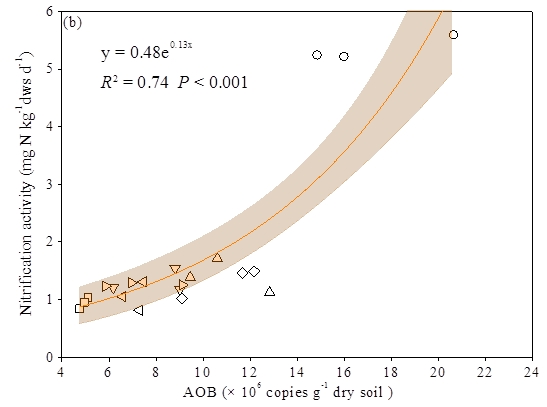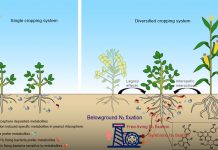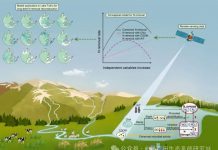Yongxin Lin, Guiping Ye, Jiafa Luo, Hong J. Di, Deyan Liu, Jianbo Fan and Weixin Ding. Nitrosospira cluster 8a play a predominant role in the nitrification process of a subtropical Ultisol under long-term inorganic and organic fertilization. Applied and Environmental Microbiology, doi: 10.1128/AEM.01031-18
Abstract
Long-term effects of inorganic and organic fertilization on nitrification activity (NA) and the abundance and community structure of ammonia oxidizing bacteria (AOB) and ammonia oxidizing archaea (AOA) were investigated in an acidic Ultisol. Seven treatments applied annually for 27 years comprised: no fertilization (control); inorganic NPK fertilizer (N); inorganic NPK fertilizer + lime (CaCO3) (NL); inorganic NPK fertilizer + peanut straw (NPS); inorganic NPK fertilizer + rice straw (NRS); inorganic NPK fertilizer + radish (NR); and, inorganic NPK fertilizer + pig manure (NPM). In non-fertilized soil, abundance of AOA was one order of magnitude higher than that of AOB. Fertilization reduced abundance of AOA, but increased that of AOB, especially in the NL treatment. The AOA communities in the control and the N treatment were dominated by Nitrososphaera and B1 clades, but shifted to clade A in the NL and NPM treatments. Nitrosospira cluster 8a was found to be the most dominant AOB in all treatments. NA was primarily regulated by soil properties, especially soil pH, and the interaction with AOB abundance explained up to 73% of variance in NA. When NL soils with neutral pH were excluded from analysis, AOB abundance, especially the relative abundance of Nitrosospira cluster 8a, was positively associated with NA. In contrast, there was no association between AOA abundance and NA. Overall, our data suggest that Nitrosospira cluster 8a of AOB played an important role in the nitrification process in the acidic soil following long-term inorganic and organic fertilization.
IMPORTANCE The nitrification process is an important step in the nitrogen (N) cycle, affecting N availability and N losses to the wider environment. Ammonia oxidation, which is the first and rate-limiting step of nitrification was widely accepted to be mainly regulated by AOA in acidic soils. However, in this study, nitrification activity was correlated with abundance of AOB rather than that of AOA in acidic Ultisols. Nitrosospira cluster 8a, a phylotype of AOB which preferred warm temperatures and low soil pH played a predominant role in nitrification process in the test Ultisols. Our results also showed that long-term application of lime or pig manure rather than plant residues altered the community structure of AOA and AOB. Taken together, our findings contributed new knowledge on the understanding of nitrification process and ammonia oxidizers in subtropical acidic Ultisol under long-term inorganic and organic fertilization.








